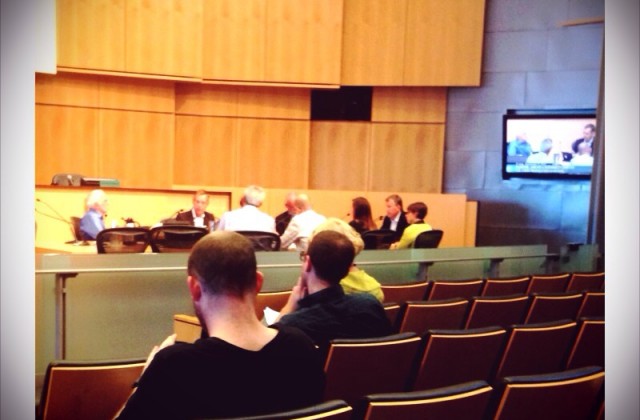Council on Microhousing: Why Lead, When We Could….Follow?
Last week the Seattle City Council started consideration of new regulations on microhousing that bear no relationship to any actual policy problem. In fact, the actual policy and economic challenge the city faces, housing people affordably, will be harmed by the legislation. Rules limiting unit size, mandating car and bike parking, more review and process for microhousing, and more sinks, will mean less (if any) microhousing at a higher price. There is one “problem” the Council is solving, however. They’ll be a lot fewer new housing choices for people moving to some Seattle neighborhoods; just what the neighborhood lobby has been pushing for. Here’s a rundown of some of the comments and proposals being made by Councilmembers that make it look like microhousing might be going away.
Regulating Unit Size
There has not been one single report of anyone harmed by the size of microhousing. The data show just the opposite: zero vacancy rates and waiting lists are the norm for microhousing buildings. People like them. And when they don’t, they eventually move somewhere else. Councilmember Burgess noted at last weeks meeting, with wonder, that Seattle has the smallest room sizes in the country. It’s true, a fact that puts Seattle in first place in housing innovation, with places like San Francisco and New York trying to catch up to us. Burgess reminds me of Dr. Evil: Why be in first place, when we could be in….third?
Councilmember Mike O’Brien made it quite clear at the meeting that the size minimums for microhousing are really a politically safe way to impose what the neighborhoods want, a density limit, meaning less housing when demand for housing is going up. O’Brien made this comment at the same meeting where he moved on a density minimum for development in transit areas. O’Brien takes density that’s working away, and then mandates it where it isn’t feasible. Welcome to the mad, mad, mad world of Seattle City Council economics.
The truth is that there is no need to regulate room or unit sizes. This simply means less housing in the same building envelope with fewer renters to offset the costs of land, financing, and construction. It means higher prices and will make many projects infeasible, something we’ll post more about later.
Bike and Car Parking
Council Tom Rasmussen’s comments at the meeting reminded me of a 1968 ad making fun of the idea of a Vice-President Spiro Agnew: they would be funny, if it weren’t so serious. Rasmussen said, with an odd smile, that as long as busses were so full, people couldn’t ride them. Those people left behind because of full buses will need to drive, so we should require more parking in transit areas. Apparently the Chair of the Council’s Transportation Committee seems to have given up on the idea of transit as a transportation solution; more parking is the answer.
And then Councilmember Clark began talking about bike parking. Shouldn’t there be at least a .75 ratio of rooms to covered bike parking spots? Why? Let’s see what other cities are doing, they asked. But as I pointed out, other cities don’t really have microhousing; we’re the leaders. Council can come look at almost any microhousing project and bike parking is set by demand. In my building there are 7 spots and 3 bikes. If more bike parking were needed, residents would demand it and builders would provide it.
Adding additional parking, as we’ve pointed out, costs as much as $40,000 per stall for a housing type that has very little customer demand for parking. The whole selling point of microhousing is it’s affordability and it’s convenience for people who don’t drive. Requiring parking in microhousing is like requiring someone with a peanut allergy to buy a jar of peanut butter every time they buy a loaf of bread; it’s not something they want to pay for, and the certainly don’t need it.
Units, Rooms, Square Footage, and Process
The Council seems to have amnesia about its own policies. A few years ago, the Council adopted a regulatory reform package that raised the unit count threshold for SEPA review. The thought behind this change was that SEPA review assumes an environmental impact from growth; but growth in transit areas, by definition, is a positive thing. Raising the threshold would reduce costs and encourage growth where we want it.
But the conversation in Committee last week was all about how to change microhousing in a way that would expose it not only to full design review (something that will raise rents), but also SEPA review and appeal. Angry neighbors are sure to exploit the appeals process to its limits, discouraging microhousing and raising its price if it does manage to get built.
Our proposal is that the best way to measure impact on existing residents is the relative size of the building, meaning square footage, not unit count, should trigger design review. Additionally why expose microhousing to SEPA review when other types of housing are now exempt from it because more housing is being encouraged?
One Sink, Two Sink, More Sinks are Better
What can I say about this that I haven’t already covered before? Residents have not demanded more sinks, and there is zero evidence in scientific literature or even anecdotally that having one sink in microhousing has even led to so much as someone getting the hiccups. Yet, the Council is considering the idea of forcing more sinks in to microhousing.
Politics Pure and Simple
What the City Council is doing is trying to regulate something that has already been doing a great job handling growing housing demand in some of Seattle’s hottest neighborhoods. We lead the country in doing this. But angry single-family neighbors (who have zero microhousing units in their zone) are driving the Council to rule and regulate the innovative solution into extinction. Council’s efforts to try and seem reasonable in responding to the red herrings offered by enfranchised neighbors, will result in fewer more expensive units because of size limits and excessive process and reviews imposed on no other type of housing.
Council thinks the angry neighbor vote can be won by squashing microhousing.
The Council should praise the innovation that has created microhousing and find a way to allow it to keep working. Instead, they are doing almost everything they can to make it harder to build, more expensive, and, in the end, more scarce and costly to renters. As I’ve pointed out, the Council seems pathologically averse to new, innovative ideas. We’ve done the math, showed the impacts, but they simply aren’t listening.




